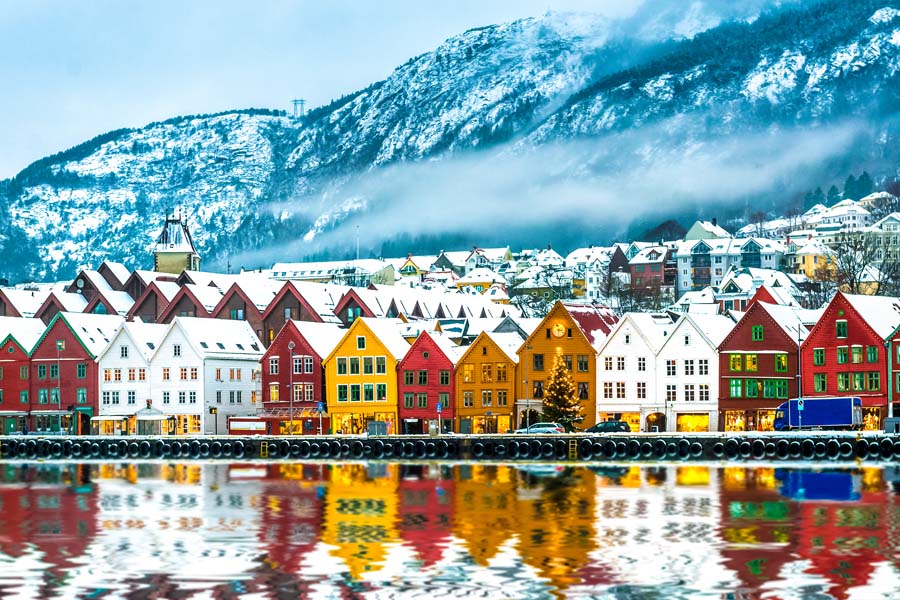As the global construction industry moves to be more sustainable, the Nordic countries have become leaders in environmentally responsive building. Innovating with materials, cutting down on carbon and reducing the amount of waste generated on the jobsite have all become standard practices in countries like Denmark, Sweden and Iceland, where public sentiment trends toward greener, cleaner living.
Now, Norway is taking an ambitious new step toward making construction more sustainable than ever before, with a plan that aims to make construction sites in cities like Bergen, Trondheim, Stavanger, Drammen, Tromsø and Kristiansand completely emission free.
Built spoke with Ryan Jorgensen of Norway-based firm Saunders Architecture about this new initiative, including the rewards of more ecologically minded construction and the challenges that lie ahead.
A greener mindset
For much of the world, the idea of enacting new construction legislation exclusively on environmental concerns would be outside the realm of possibility. But according to Jorgensen, Norway’s unique preoccupation with sustainability means the country’s culture is ideally situated to take on this challenge.
“Norway, as much of Scandinavia, has been ahead of the curve for many years,” Jorgensen said. “There is an inherent and deep respect for nature as part of the Norwegian psyche and this shows in [the country’s] approach to environmentally conscious design and construction.”
Traditional Scandinavian architecture is environmentally responsive, reflecting the materiality and aesthetics of the wooded landscape and using materials sourced from local communities.
Even in cities, residents are incentivized to place a high value on the quality of their natural environment, with a values system that centers on creating a greener society.
Urban residents in Norwegian cities, for instance, are more likely to make greener choices throughout their daily lives, with bicycle- and public transit-focused transportation networks, but the cities that are poised to go emissions free are still major drivers of pollution in the country.
Housing just under 30% of Norway’s residents, these population centers are home to the majority of the work sites that produce an estimated 1 million tons of CO2 per year through the gas-run machinery that powers conventional construction sites.
“The early adoption and implementation for zero waste in construction in Norway is something to be admired and repeated,” Jorgensen said. With this new legislation, the country’s urban centers are joining a nationwide movement toward more sustainable building.
Carbon neutral challenges
The rollout for the new plan governing greener construction in Norway’s major metropolitan areas reached its first stage in 2021. By the end of that year, the legislation mandated that all new construction and building activities within these urban zones would be free of fossil fuels in any of the equipment used on site. This entailed a switch from conventional machinery to construction technologies designed to run on renewable raw materials like biodiesel or converted entirely to electrical power.
Companies in compliance with stage one are now moving onto the next stage of the legislation, which must be finalized by 2025. By then, the legislation requires that all building and construction activities in urban zones will need to be entirely emission free, meaning that biodiesel machines will need to be transitioned to electric or hydrogen power—a move that proponents hope will address air and noise pollution, as well as carbon emissions. Within 10 years, by 2030, all construction activities in these cities are required to be entirely emission free.
While Jorgensen said these are all steps in the right direction, he believes there needs to be an increasing focus on materiality, not only jobsite conditions, for the Norwegian construction industry to make true progress on its environmental goals.
“Concrete and steel both lie high on the carbon footprint scale,” Jorgensen said. “I think with their robust forestry industry, wood and mass timber will be the solution to this.”
Jorgensen believes delving into the environmental impact of developing materials will be next on the list for Norway, saying that “lifecycle assessment of materials to determine their overall carbon footprint and investment in engineered wood” are important technological investments in the future of greener construction.
Balancing creativity and sustainability
For Jorgensen and the rest of the Saunders team, creating projects that bring together environmental concerns with livability and aesthetics has always been a critical part of their practice—a concern that Jorgensen said will continue to be at the forefront of their design process.
“We are particularly proud of our projects on Fogo Island, Newfoundland,” Jorgensen said. “Off-grid structures, water catchment, natural ventilation, composting toilets and landing lightly on the land were all essential to the sustainable goals of this remote island community.”
In building this space, Jorgensen said the Saunders team sought to create a structure that had a minimal impact on the environment, while making a memorable statement for the people who interact with it. He hopes to carry this concept into the team’s next designs over the coming year. “We have a new project that will open next year that expands these sustainable practices,” Jorgensen said, one of many ongoing projects the Saunders team aims to create under the auspices of the new pollution regulations.
For Jorgensen, regulations like the new emission standards for urban zones are a key aspect of what makes Norwegian architecture so memorable. Combining creativity and sustainability in their work has always been central to the Saunders design process, and Jorgensen believes that greener building practices that maintain a more holistic focus on the surrounding environment will continue to be a priority for him and his colleagues as they move toward new creative challenges. “Being a Norwegian-based firm, sustainable practices and ecological standards are inherent in the practice,” Jorgensen said. “Governmental standards, local availability of certified materials and a cultural practice of working in conjunction with nature all set a solid foundation for a holistic ecological practice. Creativity and sustainability are not opposing forces, but integral parts of the same whole.”












